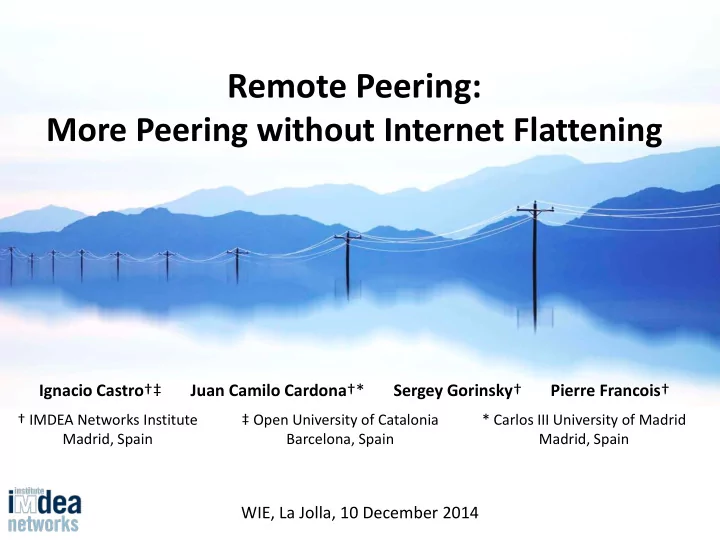

Remote Peering: More Peering without Internet Flattening Ignacio Castro †‡ Juan Camilo Cardona †* Sergey Gorinsky † Pierre Francois † † IMDEA Networks Institute ‡ Open University of Catalonia * Carlos III University of Madrid Madrid, Spain Barcelona, Spain Madrid, Spain WIE, La Jolla, 10 December 2014
“Everything depends on the color of the crystal that one looks through”
“Everything depends on the color of the crystal that one looks through” Looking at the Internet through layer-3 glasses
Modeling of Internet Economics Internet Layer-3 model Autonomous System (AS) Network Transit Provider Customer Interconnections Peering between networks Peer Peer 4
Is there anything else?
Remote-Peering Providers Remotely peering IXP Remote-peering provider AS IP router Layer-2 switch • Service components – Layer-2 connectivity of the AS to the IXP – Peering equipment at the IXP 6
Usage of Remote Peering Reaching a distant IXP African AS Reducing Connecting two IXPs costs AMS-IX over short distances ? Dutch Dutch AS AS AMS-IX Trial peering Hong Kong Remote peering 7
Usage of Remote Peering Reaching a distant IXP African AS Reducing Connecting two IXPs costs AMS-IX over short distances ? Dutch Dutch AS AS AMS-IX Trial peering Hong Kong Remote peering 8
Usage of Remote Reering Reaching a distant IXP African AS Reducing Connecting two IXPs costs AMS-IX over short distances ? Dutch Dutch AS AS AMS-IX Trial peering Hong Kong Remote peering 9
Usage of Remote Peering Reaching a distant IXP African AS Reducing Connecting two IXPs costs AMS-IX over short distances ? Dutch Dutch AS AS AMS-IX Trial peering Hong Kong Remote peering Peering 10
Our Contributions • Measurement-based studies – Spread of remote peering – Impact of remote peering on Internet traffic • Modeling of economic viability – Remote peering vs. transit and direct peering 11
Estimating the Spread • Studied questions – How many IXPs have remote peering? – How many IXP members are remote peers? • Approach – Conservative estimate – RTT (Round-Trip Time) as a metric of peer remoteness – 22 IXPs with colocated Looking Glass servers 12
Classification of Peers as Remote IXP Looking Glass ping request IP address Peering AS ping reply IP router • IP address from PCH, PeeringDB, and IXPs websites • Ping reply within one IP hop if its TTL = maximum TTL • 4 months and 6 filters to get minimum RTT reliably • If RTT > threshold, classify the peer as remote – Empirical threshold of 10 ms 13
Validation IXP Looking Glass Remotely ping request IP address peering ping reply AS IXP Remote-peering provider IP router Layer-2 switch • Public IXP information on remote peers • Ground truth from TorIX – RTT measurements – Remotely peering ASes 14
Spread across IXPs ✓ ✓ ✓ ✓ ✓ ✓ ✓ ✓ ✓ ✓ ✓ ✓ ✓ ✓ ✓ ✓ ✓ ✓ X ✓ X ✓ 91% of the IXPs have remote peering 15
Spread within IXPs Around 20% of AMS-IX peers are remote 16
Our Contributions • Measurement-based studies – Spread of remote peering – Impact of remote peering on Internet traffic • Modeling of economic viability – Remote peering vs. transit and direct peering 17
Estimating the Offload Potential • Studied questions – How can an AS benefit from remote peering? – How much traffic can the AS offload from its transit-provider links? • Evaluated AS – RedIRIS, the Spanish national academic network – 1 month of NetFlow traffic data – Routing tables 18
Transit-Provider Traffic of RedIRIS Transit providers (2) Transit Traffic RedIRIS • 2 transit providers • 29,570 ASes contribute transit traffic 19
Choice of Reached IXPs Remote peering Transit providers (2) Peering Transit Traffic IXP members RedIRIS IXPs Customer cones of IXP members • Up to 65 IXPs from Euro-IX • Reaching up to 12,238 ASes − Out of 29,570 ASes with RedIRIS transit traffic 20
Choice of Peers for RedIRIS Remote peering Transit providers (2) Peering Transit Traffic IXP members RedIRIS IXPs Customer cones of IXP members Peering policies from Peering DB 1. all open, lower bound 2. all open and top 10 selective, 3. all open and selective, 4. all policies upper bound 21
How Much Traffic can RedIRIS Offload? 8% 25% Between 8% and 25% of reduction in transit traffic 22
Utility of Reaching an Additional IXP Reaching only 5 IXPs realizes most of the offload potential 23
Is the RedIRIS Case Representative? Decreasing marginal utility of reaching an additional IXP is a general property 24
Conclusions • Remote peering, a new common interconnection – AS reaches and peers at IXP via a layer-2 provider • Potential impact on Internet traffic is substantial – Reaching only 5 IXPs realizes most of the potential • Internet economic structure needs refined models – Layer-2 entities need to be represented Contact: Ignacio Castro, ignacio.decastro@imdea.org 25
Recommend
More recommend